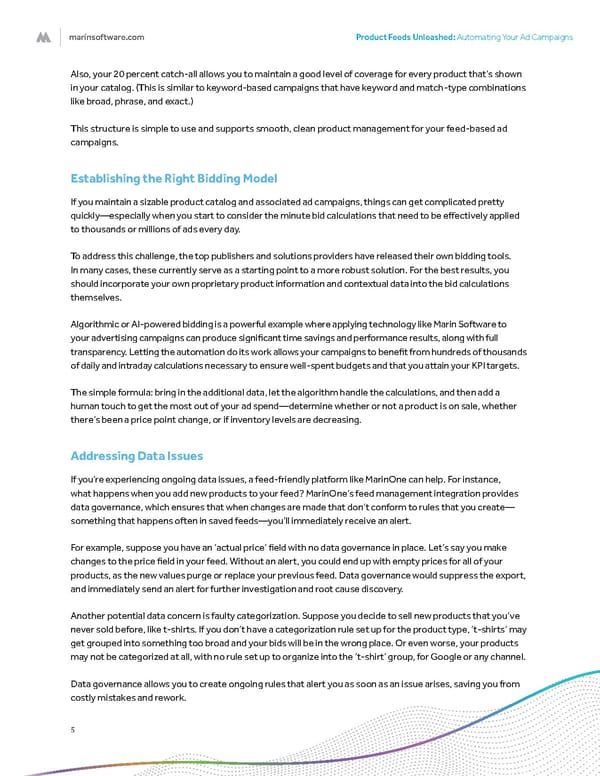marinsoftware.com Product Feeds Unleashed: Automating Your Ad Campaigns 5 Also, your 20 percent catch-all allows you to maintain a good level of coverage for every product that’s shown in your catalog. (This is similar to keyword-based campaigns that have keyword and match-type combinations like broad, phrase, and exact.) This structure is simple to use and supports smooth, clean product management for your feed-based ad campaigns. Establishing the Right Bidding Model If you maintain a sizable product catalog and associated ad campaigns, things can get complicated pretty quickly—especially when you start to consider the minute bid calculations that need to be effectively applied to thousands or millions of ads every day. To address this challenge, the top publishers and solutions providers have released their own bidding tools. In many cases, these currently serve as a starting point to a more robust solution. For the best results, you should incorporate your own proprietary product information and contextual data into the bid calculations themselves. Algorithmic or AI-powered bidding is a powerful example where applying technology like Marin Software to your advertising campaigns can produce significant time savings and performance results, along with full transparency. Letting the automation do its work allows your campaigns to benefit from hundreds of thousands of daily and intraday calculations necessary to ensure well-spent budgets and that you attain your KPI targets. The simple formula: bring in the additional data, let the algorithm handle the calculations, and then add a human touch to get the most out of your ad spend—determine whether or not a product is on sale, whether there’s been a price point change, or if inventory levels are decreasing. Addressing Data Issues If you’re experiencing ongoing data issues, a feed-friendly platform like MarinOne can help. For instance, what happens when you add new products to your feed? MarinOne’s feed management integration provides data governance, which ensures that when changes are made that don’t conform to rules that you create— something that happens often in saved feeds—you’ll immediately receive an alert. For example, suppose you have an ‘actual price’ field with no data governance in place. Let’s say you make changes to the price field in your feed. Without an alert, you could end up with empty prices for all of your products, as the new values purge or replace your previous feed. Data governance would suppress the export, and immediately send an alert for further investigation and root cause discovery. Another potential data concern is faulty categorization. Suppose you decide to sell new products that you’ve never sold before, like t-shirts. If you don’t have a categorization rule set up for the product type, ‘t-shirts’ may get grouped into something too broad and your bids will be in the wrong place. Or even worse, your products may not be categorized at all, with no rule set up to organize into the ‘t-shirt’ group, for Google or any channel. Data governance allows you to create ongoing rules that alert you as soon as an issue arises, saving you from costly mistakes and rework.
 Feed Optimization Whitepaper Page 4 Page 6
Feed Optimization Whitepaper Page 4 Page 6